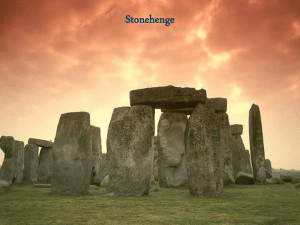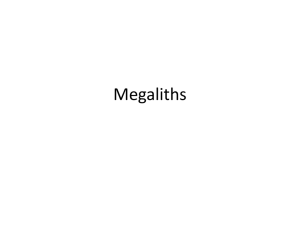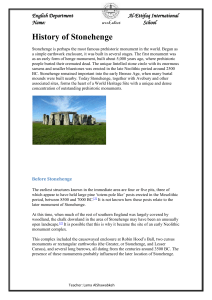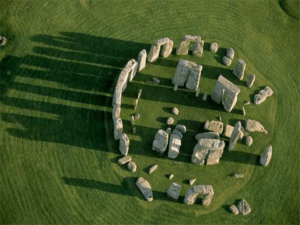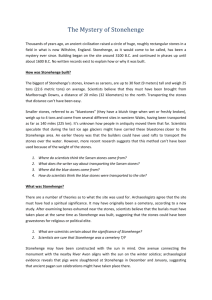"Stonehenge" articles - Riverdale High School
advertisement
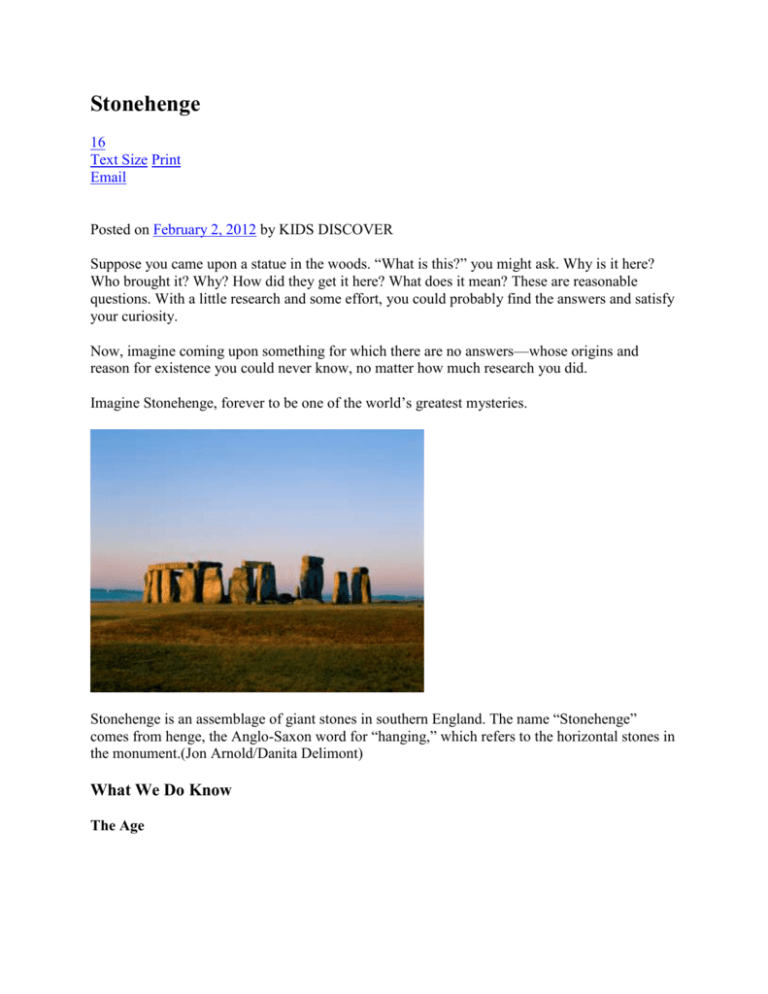
Stonehenge 16 Text Size Print Email Posted on February 2, 2012 by KIDS DISCOVER Suppose you came upon a statue in the woods. “What is this?” you might ask. Why is it here? Who brought it? Why? How did they get it here? What does it mean? These are reasonable questions. With a little research and some effort, you could probably find the answers and satisfy your curiosity. Now, imagine coming upon something for which there are no answers—whose origins and reason for existence you could never know, no matter how much research you did. Imagine Stonehenge, forever to be one of the world’s greatest mysteries. Stonehenge is an assemblage of giant stones in southern England. The name “Stonehenge” comes from henge, the Anglo-Saxon word for “hanging,” which refers to the horizontal stones in the monument.(Jon Arnold/Danita Delimont) What We Do Know The Age Stonehenge was built in phases from about 3100 B.C. to 1600 B.C. Yes, more than 5,000 years ago—during the Stone Age, long before the wheel was invented! We know this because scientists have used carbon dating to analyze the age of animal bones buried at the site. This is what Stonehenge looks like from above. The stone near the road is called the Heel Stone.(Robert Harding World Imagery/Getty Images) The Stones The monument consists of enormous stones laid out in concentric circles. The outermost circle is about 32 yards in diameter. The stones of the outer circle are sandstone columns connected by lintels about ten feet long. The lintels are shaped to the curve of the circle. Even larger blocks of sandstone and lintels form an inner semicircle. The largest of these stones weighs about as much as a fully loaded cement truck—40 tons. Today, sandstone similar to the kind at Stonehenge is found about 19 miles north, but no closer. Within the inner circle of pillars and lintels are smaller stones, called bluestones. Also arranged in a circle, some are still standing as they have been for thousands of years. Others are leaning or lying on the ground. These four-ton stones are from mountains nearly 250 miles away! The Placement A special stone called the Heel Stone stands at some distance from the main structure. Imagine standing at the center of the structure and looking toward the Heel Stone. If it were the morning of the summer or winter solstice, you would see the sun rise directly over the Heel Stone. That’s what we know about the structure. Here’s some of what we don’t know…. How were the stones transported? How were they stood on end? How were the lintels put in place? Is it mere coincidence that the sun rises and sets over the Heel Stone on the summer and winter solstice, or was the placement of the stone chosen for that very purpose? Answers to these questions represent a combination of theory and imagination. What We Think Transportation Most archaeologists maintain that people transported the stones, even the bluestones that came from so far away. According to these specialists, the stones were dragged over land and perhaps towed along the shoreline to their destination. In 2000, a group of Welsh and English volunteers participated in a reenactment of the process by moving a three-ton bluestone from the Preseli Mountains in Wales to Stonehenge. The volunteers used methods and boats they thought might have been available 5,000 years ago. To travel along the coast, the stone was towed by two boats lashed together. At a point along the way, one of the ropes snapped, and the stone sank. It took many divers and a lot of muscle power to hoist the stone back into position. Imagine what it might have taken take to house, clothe, and feed all the people needed to transport these stones! Would it have been possible? No one knows for sure. Children visit at Stonehenge, Salisbury Plain. England (Richard Nowitz/Getty Images) Many geologists contend that ancient glaciers deposited the massive boulders across the plains of southern England. These would have been gathered by the Stone Age monument-makers and transported to the site. It would have been a big job but not as big as transporting the stones nearly 250 miles. Today, the immediate area around the monument is free of large boulders. However, supporters of this view point to the many glacial remnants within a 60-mile radius to suggest that glaciers were no strangers to the area. Perhaps farmers had already removed most of the large stones. Construction What happened once the stones were at the site? How were they raised upright? And how were the lintels jacked into position? Barbara J. Becker, a historian of science, proposes the following: Image Credit: Her Majesty’s Stationary Office, 1978 However, like almost everything else about Stonehenge, we have no way of knowing for sure that this is what happened. What We Imagine Whatever your view about how Stonehenge was built, a single question remains: Why? Like much else about this mysterious monument, theories abound. Some believe the monument was an astronomical calendar. According to this group, the placement of the stones predicted solar eclipses and marked the summer and winter solstices. But would Stone Age people have had the knowledge to erect such a monument? Others contend that Stonehenge was a place of healing, a place where some type of primitive surgery was performed. As evidence, people of this view cite the nearby discovery of skeletons with crude gashes…. But the gashes could have had many origins. Still others feel that Stonehenge was a burial ground and site for ancestor worship. Skeletal remains dating from 3000 B.C. to 2500 B.C. are offered as evidence for this theory. But why here? Research scientists and others continue to explore Stonehenge and its many mysteries. For now, only two things are certain: The sun will rise over the Heel Stone to mark the next solstice. Our understanding of Stonehenge will remain incomplete. What do you think? Written by Marjorie Frank. Stonehenge by John Hudson Tiner 1 The Stonehenge people possessed an incredible blending of organization, 2 intelligence,and building skill. 3 On the Salisbury Plain in England stands Stonehenge, a magnificent circle of 4 stone arches. During the past four hundred years, visitors have tried to reason 5 out its purpose. 6 Stonehenge at first looks like a confusing series of nested stone circles. Gigantic 7 standing stones circle two horseshoe-shaped sets of blocks eighteen feet high. In 8 the center is a massive sandstone table called the Altar. Despite the name, no 9 one knows the actual use of the Altar. Beyond it is a large tapering1 stone known 10 as the Heelstone. 11 The flat Altar stone convinced scholars of the 1500s that the monument served 12 as a temple. . . . They imagined that people gathered around it and prepared to 13 go to war. Scholars had a few real facts about the site. They did know that on the 14 first day of summer, the sun rose directly over the Heelstone as seen from the 15 Altar. Most scientists thought this to be only a coincidence. 16 In 1620, Inigo Jones made the first accurate drawings of the monument. He was 17 an experienced building designer, and he decided it couldn't be the work of 18 ancient Britons. “These savage and barbarous2 people could not possibly erect 19 such a stately structure,” he said. He concluded it was the ruins of a Roman 20 temple, put in place about A.D. 100. 21 The Romans invaded England about A.D. 43. They built many permanent 22 structures that still stand. However, Stonehenge was ancient even then. The 23 Romans had not built it. 24 In1650, John Aubrey explored the site. He visited interesting places and 25 described them in books that he wrote. Aubrey discovered the remains of a 26 circular trench3 320 feet in diameter and five feet deep around Stonehenge. Just 27 inside the trench, Aubrey found 56 evenly spaced pits filled with white chalk. He 28 declared that the Druids, a mysterious group of Britons who lived about 200 B.C., 1 taper: gradually become narrower at one end uncivilized 3 trench: a long, deep hole in the ground with steep sides 2 barbarous: Tiner, J.H. (2003, December). “Stonehenge.” Nature Friend, 18-20. Retrieved SIRS Discoverer. Web. 30 Mar 2013. Used by permission. Grade 4-5/Text 2 This material is copyrighted and therefore must be securely destroyed immediately after use. DO NOT provide a copy of this material to anyone (teacher, student, or otherwise) who is not directly involved with this test administration. 3 29 used Stonehenge as a temple. For two hundred years, people accepted Aubrey’s 30 explanation. 31 In 1880, Professor William Gowland, a geology professor, dug around one of the 32 towering stones of the larger circle. He found flint4 and sandstone axes and 33 hammers that had been used in its construction. The ancient tools came from a 34 time before the Druids. Stonehenge had to be more than a thousand years old 35 when the Druids came on the scene. 36 Archaeologists today believe ancient people began construction about 3500 B.C. 37 The first version consisted of the circle of 56 holes that Aubrey discovered. About 38 2300 B.C., ancient people transported gigantic stone blocks to the site. They 39 completed the last improvement about 1000 B.C. After that, it fell into ruins. 40 A thousand years passed. The Romans invaded England. They carted away 41 some of the stones for building material. The Romans left in A.D. 410. Wind and 42 rain wore away at the stone for the next thousand years. Visitors hammered off 43 chips for souvenirs. 44 In 1958, England had the fallen stones raised. They restored Stonehenge to how 45 it appeared in Roman times. Later, they rerouted5 modern highways away from 46 the site and built an underground visitors’ center. Despite the years of neglect, it 47 remains an awe-inspiring accomplishment. 48 Why did the ancient people of England invest so much time and effort in the 49 monument? Archaeologists have made many attempts to provide an answer. 50 They found evidence that could mark celestial events6 during the course of a 51 year. 52 Early in the 1900s, the English astronomer Norman Lockyer showed that the sun 53 rose over a particular stone on the first day of summer. Other astronomers were 54 impressed with the 56 Aubrey holes. Eclipses7 of the sun and moon repeat in a 55 cycle that lasts 56 years. By moving stones around the Aubrey holes, the ancient 56 people could have computed the dates of solar and lunar8 eclipses. 4 flint: a hard quartz rock used for tools in prehistoric times send in a different direction 6 celestial event: anything of interest that happens in outer space involving planets, stars, etc. 7 eclipse: the hiding of an object in space, like the sun or moon, by another object that crosses in front of it 8 lunar: having to do with the moon 5 reroute: Tiner, J.H. (2003, December). “Stonehenge.” Nature Friend, 18-20. Retrieved SIRS Discoverer. Web. 30 Mar 2013. Used by permission. Grade 4-5/Text 2 This material is copyrighted and therefore must be securely destroyed immediately after use. DO NOT provide a copy of this material to anyone (teacher, student, or otherwise) who is not directly involved with this test administration.

